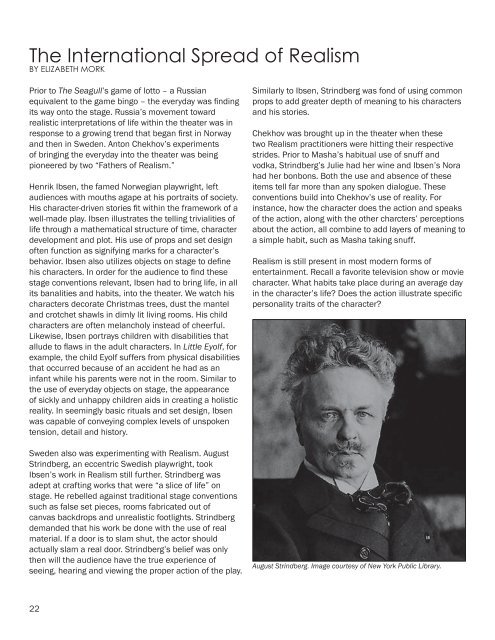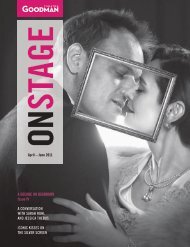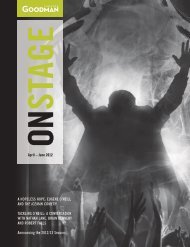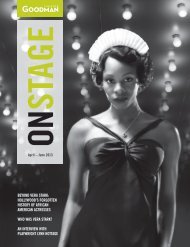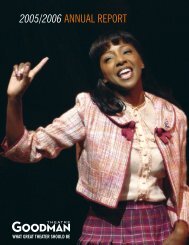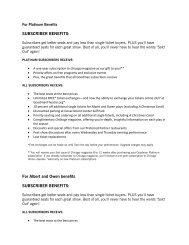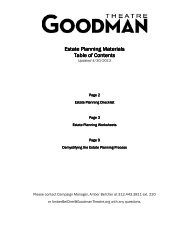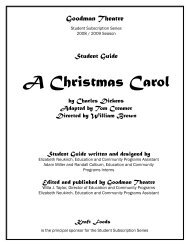The Seagull Study Guide (12MB) - Goodman Theatre
The Seagull Study Guide (12MB) - Goodman Theatre
The Seagull Study Guide (12MB) - Goodman Theatre
You also want an ePaper? Increase the reach of your titles
YUMPU automatically turns print PDFs into web optimized ePapers that Google loves.
<strong>The</strong> International Spread of Realism<br />
BY ELIZABETH MORK<br />
Prior to <strong>The</strong> <strong>Seagull</strong>’s game of lotto – a Russian<br />
equivalent to the game bingo – the everyday was finding<br />
its way onto the stage. Russia’s movement toward<br />
realistic interpretations of life within the theater was in<br />
response to a growing trend that began first in Norway<br />
and then in Sweden. Anton Chekhov’s experiments<br />
of bringing the everyday into the theater was being<br />
pioneered by two “Fathers of Realism.”<br />
Henrik Ibsen, the famed Norwegian playwright, left<br />
audiences with mouths agape at his portraits of society.<br />
His character-driven stories fit within the framework of a<br />
well-made play. Ibsen illustrates the telling trivialities of<br />
life through a mathematical structure of time, character<br />
development and plot. His use of props and set design<br />
often function as signifying marks for a character’s<br />
behavior. Ibsen also utilizes objects on stage to define<br />
his characters. In order for the audience to find these<br />
stage conventions relevant, Ibsen had to bring life, in all<br />
its banalities and habits, into the theater. We watch his<br />
characters decorate Christmas trees, dust the mantel<br />
and crotchet shawls in dimly lit living rooms. His child<br />
characters are often melancholy instead of cheerful.<br />
Likewise, Ibsen portrays children with disabilities that<br />
allude to flaws in the adult characters. In Little Eyolf, for<br />
example, the child Eyolf suffers from physical disabilities<br />
that occurred because of an accident he had as an<br />
infant while his parents were not in the room. Similar to<br />
the use of everyday objects on stage, the appearance<br />
of sickly and unhappy children aids in creating a holistic<br />
reality. In seemingly basic rituals and set design, Ibsen<br />
was capable of conveying complex levels of unspoken<br />
tension, detail and history.<br />
Sweden also was experimenting with Realism. August<br />
Strindberg, an eccentric Swedish playwright, took<br />
Ibsen’s work in Realism still further. Strindberg was<br />
adept at crafting works that were “a slice of life” on<br />
stage. He rebelled against traditional stage conventions<br />
such as false set pieces, rooms fabricated out of<br />
canvas backdrops and unrealistic footlights. Strindberg<br />
demanded that his work be done with the use of real<br />
material. If a door is to slam shut, the actor should<br />
actually slam a real door. Strindberg’s belief was only<br />
then will the audience have the true experience of<br />
seeing, hearing and viewing the proper action of the play.<br />
Similarly to Ibsen, Strindberg was fond of using common<br />
props to add greater depth of meaning to his characters<br />
and his stories.<br />
Chekhov was brought up in the theater when these<br />
two Realism practitioners were hitting their respective<br />
strides. Prior to Masha’s habitual use of snuff and<br />
vodka, Strindberg’s Julie had her wine and Ibsen’s Nora<br />
had her bonbons. Both the use and absence of these<br />
items tell far more than any spoken dialogue. <strong>The</strong>se<br />
conventions build into Chekhov’s use of reality. For<br />
instance, how the character does the action and speaks<br />
of the action, along with the other charcters’ perceptions<br />
about the action, all combine to add layers of meaning to<br />
a simple habit, such as Masha taking snuff.<br />
Realism is still present in most modern forms of<br />
entertainment. Recall a favorite television show or movie<br />
character. What habits take place during an average day<br />
in the character’s life? Does the action illustrate specific<br />
personality traits of the character?<br />
August Strindberg. Image courtesy of New York Public Library.<br />
22


